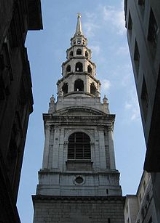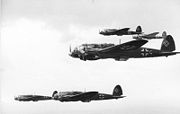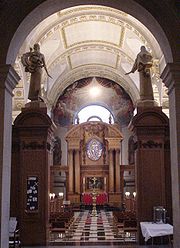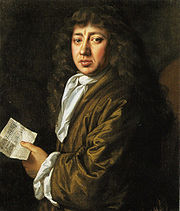
St Bride's Church
Encyclopedia
St Bride's Church is a church in the City of London
, England
. The building's most recent incarnation was designed by Sir Christopher Wren in 1672 on Fleet Street
in the City of London
, though Wren's original building was largely gutted by fire during the London Blitz in 1940. Due to its location on Fleet Street it has a long association with journalists
and newspaper
s. The church is a distinctive sight on London
's skyline and is clearly visible from a number of locations. Standing 69 metres high, it is the 2nd tallest of all Wren's churches, with only St Paul's
itself having a higher pinnacle. The tiered spire is said to have been the inspiration for the design of modern tiered wedding cake
s.
in the 7th century. It has been conjectured that, as the patron saint is St Bridget of Ireland, it may have been founded by Celtic monks
, missionaries proselytising the English.
The present St Bride's is at least the seventh church to have stood on the site. Traditionally it was founded by St Bridget in the sixth century. Whether or not she founded it personally, the remnants of the first church appear to have significant similarities to a church of the same date in Kildare
, Ireland
. The Norman
church, built in the 11th century, was of both religious and secular significance; in 1210 King John
held a parliament there. It was replaced by a larger church in the 15th century,
St Bride's association with the newspaper business began in 1500 when Wynkyn de Worde
set up a printing press next door. Until 1695 London was the only city in Britain where printing was permitted by law.
, daughter to the gentleman artist and explorer John White, was married in St Bride's, to the tiler and bricklayer Ananias Dare. Their daughter Virginia Dare
was to be the first English child born in North America. She was born on Roanoke Island
on August 19, 1587: "Elenora, daughter to the governour and wife to Ananias Dare, one of the assistants, was delivered of a daughter in Roanoke". The child was healthy and "was christened there the Sunday following, and because this childe was the first Christian borne in Virginia, she was named Virginia". A modern bust of Virginia Dare stands near the font, replacing an earlier monument which was stolen and has not been recovered.
killed 238 parishioners in a single week, and in 1666, the following year, the church was completely destroyed during the Great Fire of London
, which burned much of the city. After the fire, the old church was replaced by an entirely new building designed by Sir Christopher Wren, one of his largest and most expensive works, taking seven years to build.
The famous spire was added later, in 1701-1703. It originally measured 234 ft but lost its upper eight feet to a lightning strike in 1764; this was then bought by the then owner of Park Place, Berkshire
, where it still resides. The design utilises four octagonal stages of diminishing height capped with an obelisk which terminates in a ball and vane.
Buried at St. Bride's is Robert Levet
(Levett
), a Yorkshireman who became a Parisian waiter, then a 'practicer of physick' who ministered to the denizens of London's seedier neighbourhoods. Having been duped into a bad marriage, the hapless Levet was taken in by the author Samuel Johnson
who wrote his poem "On the Death of Mr. Robert Levet" eulogizing his good friend and tenant of many years. Also buried at St Bride's are the organist and composer, Thomas Weelkes
(d. 1623) and the poet, Richard Lovelace
(d.1658), as well as author Samuel Richardson
(d. 1761)
 The church was gutted by fire-bombs dropped by the Luftwaffe
The church was gutted by fire-bombs dropped by the Luftwaffe
during the London Blitz of the Second World War, on the night of 29 December 1940, dubbed the "Second Great Fire of London" due to the enormous amount of damage caused. Some 1500 fires were started, including three major conflagrations; consequently causing a firestorm. St Paul's Cathedral
itself was only saved by the dedication of the London firemen who kept the fire away from the Cathedral and the volunteer firewatchers of the St Paul's Watch who fought to keep the flames from firebombs on its roof from spreading. After the war, the St Brides's was rebuilt at the expense of newspaper proprietors and journalists.
One fortunate and unintended consequence of the bombing was the excavation of the church's original sixth century Saxon foundations. Today the crypt, known as the Museum of Fleet Street, is open to the public and contains a number of ancient relics including Roman coins and medieval stained glass.
 In September 2007 the current vicar, Canon David Meara announced a special appeal to raise 3.5 million GBP to preserve the church's unique heritage and on November 2007 The Queen
In September 2007 the current vicar, Canon David Meara announced a special appeal to raise 3.5 million GBP to preserve the church's unique heritage and on November 2007 The Queen
was guest of honour at a service to celebrate the 50th anniversary of the restoration work necessary after the Second World War.
The church was designated a Grade I listed building on 4 January 1950. The church also has a place in sport, as the world table tennis men's singles champion is awarded the St. Bride vase.
The organ
is built by the John Compton Organ Company, and arguably their finest work, the organ was ready for the Rededication of the Church in November 1957. It has recently been completely overhauled and cleaned by Keith Bance, who has carried out some modest tonal updating. This included remodelling the Positive division, adding new Mixture stops to the Great and Pedal divisions and the provision of a new Vox Humana for the Solo division. These changes have further increased the resources of an already versatile instrument. The organ has four manuals, 98 speaking stops, close to 4000 pipes, a multi-level capture system and the wind is provided by four blowing installations.
 St Bride's has had a number of notable parishioners, including John Milton
St Bride's has had a number of notable parishioners, including John Milton
, John Dryden
, and the diarist Samuel Pepys
, who was baptized in the church. Pepys buried his brother Tom in the church in 1664, but by this stage the vaults were so overcrowded that Pepys had to bribe the gravedigger to "justle together" the corpses in order to make room. In 2009, Sir Clement Freud
's funeral was held in the church.
City of London
The City of London is a small area within Greater London, England. It is the historic core of London around which the modern conurbation grew and has held city status since time immemorial. The City’s boundaries have remained almost unchanged since the Middle Ages, and it is now only a tiny part of...
, England
England
England is a country that is part of the United Kingdom. It shares land borders with Scotland to the north and Wales to the west; the Irish Sea is to the north west, the Celtic Sea to the south west, with the North Sea to the east and the English Channel to the south separating it from continental...
. The building's most recent incarnation was designed by Sir Christopher Wren in 1672 on Fleet Street
Fleet Street
Fleet Street is a street in central London, United Kingdom, named after the River Fleet, a stream that now flows underground. It was the home of the British press until the 1980s...
in the City of London
City of London
The City of London is a small area within Greater London, England. It is the historic core of London around which the modern conurbation grew and has held city status since time immemorial. The City’s boundaries have remained almost unchanged since the Middle Ages, and it is now only a tiny part of...
, though Wren's original building was largely gutted by fire during the London Blitz in 1940. Due to its location on Fleet Street it has a long association with journalists
Journalism
Journalism is the practice of investigation and reporting of events, issues and trends to a broad audience in a timely fashion. Though there are many variations of journalism, the ideal is to inform the intended audience. Along with covering organizations and institutions such as government and...
and newspaper
Newspaper
A newspaper is a scheduled publication containing news of current events, informative articles, diverse features and advertising. It usually is printed on relatively inexpensive, low-grade paper such as newsprint. By 2007, there were 6580 daily newspapers in the world selling 395 million copies a...
s. The church is a distinctive sight on London
London
London is the capital city of :England and the :United Kingdom, the largest metropolitan area in the United Kingdom, and the largest urban zone in the European Union by most measures. Located on the River Thames, London has been a major settlement for two millennia, its history going back to its...
's skyline and is clearly visible from a number of locations. Standing 69 metres high, it is the 2nd tallest of all Wren's churches, with only St Paul's
St Paul's Cathedral
St Paul's Cathedral, London, is a Church of England cathedral and seat of the Bishop of London. Its dedication to Paul the Apostle dates back to the original church on this site, founded in AD 604. St Paul's sits at the top of Ludgate Hill, the highest point in the City of London, and is the mother...
itself having a higher pinnacle. The tiered spire is said to have been the inspiration for the design of modern tiered wedding cake
Wedding cake
A wedding cake is the traditional cake served to the guests at a wedding reception after a wedding. In modern Western culture, it is usually a large cake, multi-layered or tiered, and heavily decorated with icing, usually over a layer of marzipan or fondant...
s.
Origins
St. Bride's may be one of the most ancient churches in London, with worship perhaps dating back to the conversion of the Middle SaxonsSaxons
The Saxons were a confederation of Germanic tribes originating on the North German plain. The Saxons earliest known area of settlement is Northern Albingia, an area approximately that of modern Holstein...
in the 7th century. It has been conjectured that, as the patron saint is St Bridget of Ireland, it may have been founded by Celtic monks
Celtic Christianity
Celtic Christianity or Insular Christianity refers broadly to certain features of Christianity that were common, or held to be common, across the Celtic-speaking world during the Early Middle Ages...
, missionaries proselytising the English.
The present St Bride's is at least the seventh church to have stood on the site. Traditionally it was founded by St Bridget in the sixth century. Whether or not she founded it personally, the remnants of the first church appear to have significant similarities to a church of the same date in Kildare
Kildare
-External links:*******...
, Ireland
Ireland
Ireland is an island to the northwest of continental Europe. It is the third-largest island in Europe and the twentieth-largest island on Earth...
. The Norman
Norman architecture
About|Romanesque architecture, primarily English|other buildings in Normandy|Architecture of Normandy.File:Durham Cathedral. Nave by James Valentine c.1890.jpg|thumb|200px|The nave of Durham Cathedral demonstrates the characteristic round arched style, though use of shallow pointed arches above the...
church, built in the 11th century, was of both religious and secular significance; in 1210 King John
John of England
John , also known as John Lackland , was King of England from 6 April 1199 until his death...
held a parliament there. It was replaced by a larger church in the 15th century,
St Bride's association with the newspaper business began in 1500 when Wynkyn de Worde
Wynkyn de Worde
Wynkyn de Worde was a printer and publisher in London known for his work with William Caxton, and is recognized as the first to popularize the products of the printing press in England....
set up a printing press next door. Until 1695 London was the only city in Britain where printing was permitted by law.
Roanoke colony
In the late 1580s one Eleanor WhiteEleanor Dare
Eleanor White Dare of Westminster, London, England was a member of the Roanoke Colony and the daughter of John White, the colony's governor. While little is known about her life, more is known about her than most of the sixteen other women who left England in 1587 as part of the Roanoke...
, daughter to the gentleman artist and explorer John White, was married in St Bride's, to the tiler and bricklayer Ananias Dare. Their daughter Virginia Dare
Virginia Dare
Virginia Dare was the first child born in the Americas to English parents, Eleanor and Ananias Dare. She was born into the short-lived Roanoke Colony in what is now North Carolina, USA. What became of Virginia and the other colonists remains a mystery...
was to be the first English child born in North America. She was born on Roanoke Island
Roanoke Island
Roanoke Island is an island in Dare County near the coast of North Carolina, United States. It was named after the historical Roanoke Carolina Algonquian people who inhabited the area in the 16th century at the time of English exploration....
on August 19, 1587: "Elenora, daughter to the governour and wife to Ananias Dare, one of the assistants, was delivered of a daughter in Roanoke". The child was healthy and "was christened there the Sunday following, and because this childe was the first Christian borne in Virginia, she was named Virginia". A modern bust of Virginia Dare stands near the font, replacing an earlier monument which was stolen and has not been recovered.
Great Fire of London
In the mid-seventeenth century disaster struck. In 1665 the Great Plague of LondonGreat Plague of London
The Great Plague was a massive outbreak of disease in the Kingdom of England that killed an estimated 100,000 people, 20% of London's population. The disease is identified as bubonic plague, an infection by the bacterium Yersinia pestis, transmitted through a flea vector...
killed 238 parishioners in a single week, and in 1666, the following year, the church was completely destroyed during the Great Fire of London
Great Fire of London
The Great Fire of London was a major conflagration that swept through the central parts of the English city of London, from Sunday, 2 September to Wednesday, 5 September 1666. The fire gutted the medieval City of London inside the old Roman City Wall...
, which burned much of the city. After the fire, the old church was replaced by an entirely new building designed by Sir Christopher Wren, one of his largest and most expensive works, taking seven years to build.
The famous spire was added later, in 1701-1703. It originally measured 234 ft but lost its upper eight feet to a lightning strike in 1764; this was then bought by the then owner of Park Place, Berkshire
Park Place, Berkshire
Park Place is a historic Grade II Listed country house and gardens in the civil parish of Remenham in Berkshire, England, set in large grounds above the River Thames near Henley, Oxfordshire.-History:...
, where it still resides. The design utilises four octagonal stages of diminishing height capped with an obelisk which terminates in a ball and vane.
Buried at St. Bride's is Robert Levet
Robert Levet
Robert Levet , a Yorkshireman who became a Parisian waiter, then garnered some training as an apothecary and moved to London, was eulogized by the poet Samuel Johnson, with whom Levet shared a friendship of thirty-six years, in Johnson's poem "On the Death of Dr...
(Levett
Levett
Levett is an Anglo-Norman territorial surname deriving from the village of Livet-en-Ouche, now Jonquerets-de-Livet, in Eure, Normandy. Ancestors of the earliest Levett family in England, the de Livets were lords of the village of Livet, and undertenants of the de Ferrers, among the most powerful of...
), a Yorkshireman who became a Parisian waiter, then a 'practicer of physick' who ministered to the denizens of London's seedier neighbourhoods. Having been duped into a bad marriage, the hapless Levet was taken in by the author Samuel Johnson
Samuel Johnson
Samuel Johnson , often referred to as Dr. Johnson, was an English author who made lasting contributions to English literature as a poet, essayist, moralist, literary critic, biographer, editor and lexicographer...
who wrote his poem "On the Death of Mr. Robert Levet" eulogizing his good friend and tenant of many years. Also buried at St Bride's are the organist and composer, Thomas Weelkes
Thomas Weelkes
Thomas Weelkes was an English composer and organist. He became organist of Winchester College in 1598, moving to Chichester Cathedral. His works are chiefly vocal, and include madrigals, anthems and services.-Life:Weelkes was baptised in the little village church of Elsted in Sussex on 25...
(d. 1623) and the poet, Richard Lovelace
Richard Lovelace
Richard Lovelace was an English poet in the seventeenth century. He was a cavalier poet who fought on behalf of the king during the Civil war. His best known works are To Althea, from Prison, and To Lucasta, Going to the Warres....
(d.1658), as well as author Samuel Richardson
Samuel Richardson
Samuel Richardson was an 18th-century English writer and printer. He is best known for his three epistolary novels: Pamela: Or, Virtue Rewarded , Clarissa: Or the History of a Young Lady and The History of Sir Charles Grandison...
(d. 1761)
WWII

Luftwaffe
Luftwaffe is a generic German term for an air force. It is also the official name for two of the four historic German air forces, the Wehrmacht air arm founded in 1935 and disbanded in 1946; and the current Bundeswehr air arm founded in 1956....
during the London Blitz of the Second World War, on the night of 29 December 1940, dubbed the "Second Great Fire of London" due to the enormous amount of damage caused. Some 1500 fires were started, including three major conflagrations; consequently causing a firestorm. St Paul's Cathedral
St Paul's Cathedral
St Paul's Cathedral, London, is a Church of England cathedral and seat of the Bishop of London. Its dedication to Paul the Apostle dates back to the original church on this site, founded in AD 604. St Paul's sits at the top of Ludgate Hill, the highest point in the City of London, and is the mother...
itself was only saved by the dedication of the London firemen who kept the fire away from the Cathedral and the volunteer firewatchers of the St Paul's Watch who fought to keep the flames from firebombs on its roof from spreading. After the war, the St Brides's was rebuilt at the expense of newspaper proprietors and journalists.
One fortunate and unintended consequence of the bombing was the excavation of the church's original sixth century Saxon foundations. Today the crypt, known as the Museum of Fleet Street, is open to the public and contains a number of ancient relics including Roman coins and medieval stained glass.
Modern Era

Elizabeth II of the United Kingdom
Elizabeth II is the constitutional monarch of 16 sovereign states known as the Commonwealth realms: the United Kingdom, Canada, Australia, New Zealand, Jamaica, Barbados, the Bahamas, Grenada, Papua New Guinea, the Solomon Islands, Tuvalu, Saint Lucia, Saint Vincent and the Grenadines, Belize,...
was guest of honour at a service to celebrate the 50th anniversary of the restoration work necessary after the Second World War.
The church was designated a Grade I listed building on 4 January 1950. The church also has a place in sport, as the world table tennis men's singles champion is awarded the St. Bride vase.
Music
The choir in its present form (12 professional singers - 4 sopranos, 2 altos, 3 tenors and 3 basses) was established in time for the re-dedication service in 1957, and has remained more or less in this format ever since. The choir sings at two services each Sunday throughout the year (reducing to 8 singers during August) and also for numerous special services. The Director of Music is Robert Jones, and the Assistant Director of Music is Matthew Morley.The organ
Pipe organ
The pipe organ is a musical instrument that produces sound by driving pressurized air through pipes selected via a keyboard. Because each organ pipe produces a single pitch, the pipes are provided in sets called ranks, each of which has a common timbre and volume throughout the keyboard compass...
is built by the John Compton Organ Company, and arguably their finest work, the organ was ready for the Rededication of the Church in November 1957. It has recently been completely overhauled and cleaned by Keith Bance, who has carried out some modest tonal updating. This included remodelling the Positive division, adding new Mixture stops to the Great and Pedal divisions and the provision of a new Vox Humana for the Solo division. These changes have further increased the resources of an already versatile instrument. The organ has four manuals, 98 speaking stops, close to 4000 pipes, a multi-level capture system and the wind is provided by four blowing installations.
Organists
- Henry Lightindollar 1696-1702
- John Weldon 1702-1736
- Samuel Howard 1736-1782
- Richard Huddleston Potter 1782-1821
- George Mather 1821-1854
- Mr. Reynolds 1854-????
- Ernest Kiver 1882-????
- John D. Codner ????-1888 (later organist of St. David's Cathedral)
- Edmund Hart Turpin 1888-1909
- Herbert Townsend 1909 - ca. 1921
- Gordon Reynolds 1952-1965
- Robert Langston 1972-1988
- Robert Harre-Jones 1988-current
Notable Parishioners

John Milton
John Milton was an English poet, polemicist, a scholarly man of letters, and a civil servant for the Commonwealth of England under Oliver Cromwell...
, John Dryden
John Dryden
John Dryden was an influential English poet, literary critic, translator, and playwright who dominated the literary life of Restoration England to such a point that the period came to be known in literary circles as the Age of Dryden.Walter Scott called him "Glorious John." He was made Poet...
, and the diarist Samuel Pepys
Samuel Pepys
Samuel Pepys FRS, MP, JP, was an English naval administrator and Member of Parliament who is now most famous for the diary he kept for a decade while still a relatively young man...
, who was baptized in the church. Pepys buried his brother Tom in the church in 1664, but by this stage the vaults were so overcrowded that Pepys had to bribe the gravedigger to "justle together" the corpses in order to make room. In 2009, Sir Clement Freud
Clement Freud
Sir Clement Raphael Freud was an English broadcaster, writer, politician and chef.-Early life:Freud was born in Berlin, the son of Jewish parents Ernst Ludwig Freud and Lucie née Brasch. He was the grandson of psychoanalyst Sigmund Freud and the brother of artist Lucian Freud...
's funeral was held in the church.
See also
- List of churches and cathedrals of London
- List of Christopher Wren churches in London
- St Bride LibrarySt Bride LibrarySt Bride Library is a library in London primarily devoted to printing, book arts, typography and graphic design...
External links
- St Bride's Church - Official Website
- St. Bride's Church - Sacred Destinations
- Mystery Worshipper Report at the Ship of Fools websiteShip of Fools (website)Ship of Fools is a UK-based Christian website. It was first launched as a magazine in 1977. The magazine folded in 1983 and was resurrected as a website on April Fool's Day, 1998. Subtitled "the magazine of Christian unrest", Ship of Fools pokes fun and asks critical questions about the Christian...

